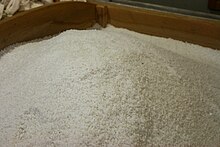Sečovlje salt pans
The Sečovlje saltworks ( Slovene Sečoveljske soline , Italian Saline di Sicciole , formerly Piran saltworks , Slovene Piranske soline , Italian saltworks di Pirano ) are a nature park with an area of 6.5 km² in the vicinity of Seča in the area the municipality of Piran , Slovenia . They are right on the Croatian border in the bay of Piran . The nature park is bordered in the north by the St. Bartholomew Canal and in the south by the Dragonja River . The northern part of the salt pans is called Lera , the southern Fortanigge .
Salt extraction
Lera is still cultivated today to maintain the traditional salt production on a smaller scale and still without the use of machines. These are the most northerly active salt pans in the Mediterranean after the Strunjan salt pans. They are in operation for 4 months a year, from April 24th to August 25th. The salt obtained is then temporarily stored and packaged in Portorož in the Magazen grando salt warehouse built in 1858 .
In Fortanigge, salt production was given up in the 1960s. The ruins of the saline workers' houses have already been reclaimed by nature, the sea dams have been flooded.
Flora
The salt fields, canals and earth walls are an important biotope for plants and animals that specialize in high salt content in the water. Fortanigge in particular is characterized by reeds and the basins, which are partly overgrown by halophyte meadows. Common salt plants are the samphire , the purslane wedge and the beach sod . The most striking halophyte, however, is the sea lavender with tiny purple flowers and salt glands on the leaves. In autumn the halophyte meadows turn red-purple due to the lack of nitrogen .
Wildlife
A characteristic animal for the salt basins is the brine shrimp , a red plankton species almost 1 cm in size. The Mediterranean carp is also well adapted to the high salt content in the water .
However, the animal world is essentially dominated by birds. Over 270 bird species have been documented, 90 of which also breed here. a. the stilt , the little tern , the white-headed gull , the common tern, and the Kentish plover . This makes the salt flats the most important breeding area in Slovenia. Three species of heron live in the salt pans all year round, even if they do not breed here: the great egret , the gray heron and the smaller little egret . The bird fauna is most impressive in spring and autumn when flocks of migratory birds take a break in the salt flats.
Others
In 1993 the salt pans were included in the list of wetlands of international importance by the Ramsar Convention . In 2001 the Slovenian government granted the area the status of a national monument.
There is a salt works museum and a small information center for visitors.
photos
swell
- Information from the Sečovelje Saltworks Nature Park, Seča 115, SI-6320 Portorož
Web links
- Homepage of the operator of the Krajinski park Sečoveljske soline nature park on kpss.si (English).
- Homepage of the operator of the salt works on soline.si (English).
Coordinates: 45 ° 29 ′ 30.3 ″ N , 13 ° 36 ′ 30.2 ″ E








